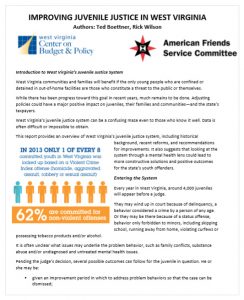 Every year in West Virginia, around 4,000 juveniles will appear before a judge. Pending the judge’s decision, a juvenile may be given an improvement period to address the behavior, put on probation, referred to a special court, or committed to some form of out-of-home placement. However, the state’s juvenile justice system can be confusing and data is often difficult or impossible to obtain.
Every year in West Virginia, around 4,000 juveniles will appear before a judge. Pending the judge’s decision, a juvenile may be given an improvement period to address the behavior, put on probation, referred to a special court, or committed to some form of out-of-home placement. However, the state’s juvenile justice system can be confusing and data is often difficult or impossible to obtain.
This report provides an overview of West Virginia’s juvenile justice system, including historical background, recent reforms, and recommendations for improvements. It also suggests looking at the system through a mental health lens could lead to more constructive solutions and positive outcomes for the state’s youth offenders. “When West Virginia confines a young person for a minor, non-violent offense, too often it puts him or her at risk of being drawn more deeply into the criminal justice system,” said Sean O’Leary, West Virginia Center on Budget and Policy Interim Executive Director. “While the state has recently embarked on the path of juvenile justice reform, there is still more work to be done. A greater focus on juvenile mental health would help West Virginia build on its recent progress.”
Key Findings
- West Virginia bucks the national trend with its high confinement rates. It was one of only five states where the rate of detention increased, despite a drop in both crime and population.
- In 2013, West Virginia confined juveniles at a rate of 510 per 10,000. By contrast, Massachusetts, with nearly four times the population of West Virginia, had just 393 youth in confinement.
- African American youth were nearly three times as likely to be confined as their white counterparts. West Virginia’s youth confinement rate for African Americans was 1.5 times higher than the national average.
- West Virginia was second only to Wyoming to confining young females. With a rate of 175 per 100,000, the Mountain State far exceeded the national rate of 47.
- Incarceration or other forms of detainment early in life are a major life disruption in the ordinary life course, which can have ripple effects into the future. Prior incarceration was a greater predictor of recidivism than carrying a weapon, gang membership, or poor parental relationships.
- In 2013, only one out of every eight committed youth in West Virginia was locked up based on a violent crime, such as homicide, aggravated assault, robbery, or sexual assault.
- Community-based programs were more cost-efficient and effective with recidivism rates than DJS facilities.
- In 2014, Governor Earl Ray Tomblin convened the West Virginia Intergovernmental Task Force on Juvenile Justice, which brought together legislative and judicial leaders as well as system experts to conduct a comprehensive analysis of the state’s system and to produce policy recommendations.
- West Virginia’s juvenile justice system has made real progress, however, it continues to face significant problems, particularly in the area of juvenile mental health.
- Looking at the system through a mental health lens could lead to more constructive solutions and positive outcomes for youth offenders. Some next steps include: creating a task force to address juvenile mental health; build the infrastructure to help public schools address mental health issues before a student is suspended or sent to court; and a long-term goal should to build an infrastructure which would ensure that students in danger of entering the system are assessed and referred to appropriate community-based programs whenever possible and appropriate.
- West Virginia’s communities, families, and youth will benefit if the only young people who are confined or detained in out-of-home facilities are those who constitute a threat to the public or themselves.
 Every year in West Virginia, around 4,000 juveniles will appear before a judge. Pending the judge’s decision, a juvenile may be given an improvement period to address the behavior, put on probation, referred to a special court, or committed to some form of out-of-home placement. However, the state’s juvenile justice system can be confusing and data is often difficult or impossible to obtain.
Every year in West Virginia, around 4,000 juveniles will appear before a judge. Pending the judge’s decision, a juvenile may be given an improvement period to address the behavior, put on probation, referred to a special court, or committed to some form of out-of-home placement. However, the state’s juvenile justice system can be confusing and data is often difficult or impossible to obtain.